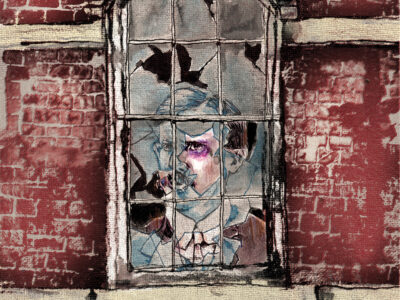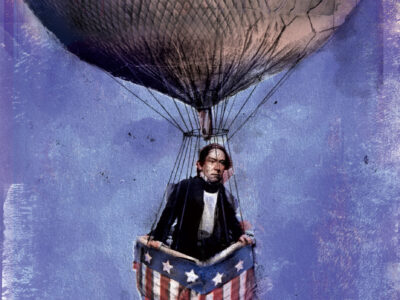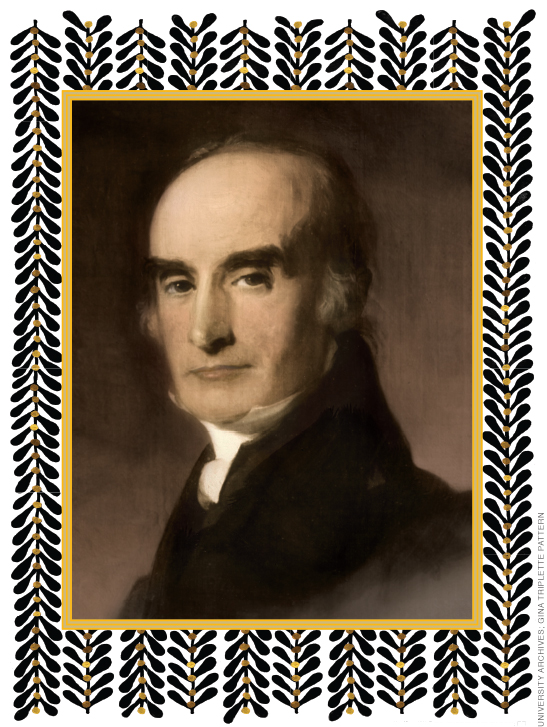
In successfully defending the irascible Supreme Court Justice Samuel Chase—aka “Old Bacon Face”—against impeachment, Joseph Hopkinson C1786 G1789 helped set a high bar for removal from office and establish the principle of judicial independence.
BY DENNIS DRABELLE
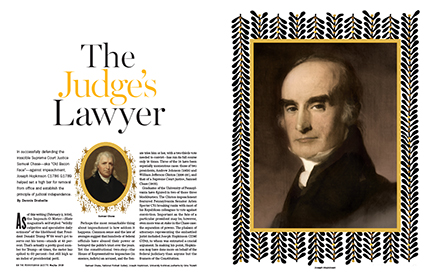
As of this writing (February 9, 2018), the Impeach-O-Meter—Slate magazine’s self-styled “wildly subjective and speculative daily estimate” of the likelihood that President Donald Trump W’68 won’t get to serve out his term—stands at 45 percent. That’s actually a pretty good number for Trump—at times, the meter has spiked to 60 percent—but still high as an index of presidential peril.
Perhaps the most remarkable thing about impeachment is how seldom it happens. Common sense and the law of averages suggest that hundreds of federal officials have abused their power or betrayed the public’s trust over the years. Yet the constitutional two-step—the House of Representatives impeaches (in essence, indicts) an accused, and the Senate tries him or her, with a two-thirds vote needed to convict—has run its full course only 18 times. Three of the 18 have been especially momentous cases: those of two presidents, Andrew Johnson (1868) and William Jefferson Clinton (1998-99), and that of a Supreme Court justice, Samuel Chase (1805).
Graduates of the University of Pennsylvania have figured in two of those three blockbusters. The Clinton impeachment featured Pennsylvania Senator Arlen Specter C’51 breaking ranks with most of his Republican colleagues to vote against conviction. Important as the fate of a particular president may be, however, even more was at stake in the Chase case: the separation of powers. The phalanx of attorneys representing the embattled jurist included Joseph Hopkinson C1786 G1789, to whom was entrusted a crucial argument. In making his point, Hopkinson may have done more on behalf of the federal judiciary than anyone but the framers of the Constitution.
Joseph Hopkinson came from a line of English lawyers, one of whom, his grandfather Thomas Hopkinson, migrated to the New World around 1730 to better represent his London mercantile clients. Thomas died in 1751, whereupon his friend Benjamin Franklin took under his wing Thomas’s 14-year-old son, Francis C1757 G1760 Hon1790 [“The Artful Rebel,” May|June 2012]. Their closeness survived Franklin’s own death in 1790—Francis was one of the executors of the old man’s will. By then, he had graduated in the first class of what evolved into the University of Pennsylvania, studied law, married, and set up a practice in New Jersey.
In 1775, New Jersey sent Francis as one of its representatives to the Continental Congress; the following year, he signed the Declaration of Independence. Appointed a Pennsylvania state judge in 1780, he quickly ran afoul of certain legislators, who impeached him. Although Francis was acquitted and went on to serve as a federal judge, the scare probably weighed on the mind of his son Joseph when he defended Justice Chase a generation later. Francis was also a satirist, musician, and artist whose masterpiece was the design of the American flag. As we shall see, his son lived up to that sparkling heritage.
Born in 1770, Joseph entered Penn at the age of 13. After graduating at 15 and a half, he read law with the brilliant James Wilson [“Flawed Founder,” May|Jun 2011] and was admitted to the bar in 1791.
In the meantime, the young man had made a name for himself as a wit, notably in “A Defense of Luxury,” an essay he read to the Literary and Commercial Society of Philadelphia, a group of young Philadelphians bent on self-improvement. “For my part,” Hopkinson wrote, “I must confess that I differ from all those learned gentlemen, both ancient and modern, who have been such enemies to mankind as to attempt to retard the growth of that cash-diffusing plant—Luxury.” He helped found the Law Society of Philadelphia, among whose members was Charles Brockden Brown, soon to be America’s first professional author. (Brown’s Gothic romance Wieland is arguably the earliest American novel that can still be read with pleasure.)
Hopkinson hung out his first shingle in Easton, Pennsylvania, but spent a good deal of time in Philadelphia, where he met and married Emily Mifflin, the daughter of the governor of Pennsylvania. Hopkinson became a leading light in the generation that, according to his biographer, Burton Alva Konkle, made “Philadelphia lawyer” a byword for professional excellence. In his spare time, Hopkinson probably supervised the first American publication of Shakespeare’s works. We can’t be sure of this—his name does not appear on the title page or anywhere else—but people assumed he was behind the project at the time, and the preface smacks of lawyerly rhetoric brought to bear on literary controversy: “Some critics have dreamed that if possessed of more learning, [Shakespeare] would have been less original, and that erudition would have dampened the ardor of his genius. This is like believing a man will forget how to walk by learning to dance.”
Hopkinson danced his way through his first big case in 1797, when he represented Dr. Benjamin Rush, a Founding Father who was also a doyen of early American medicine. Yellow fever had ravaged Philadelphia and the Delaware Valley, and William Cobbett, the English-born publisher of a Philadelphia newspaper called Porcupine’s Gazette, had chastised Rush in print for his method of treating the disease: bleed the patient. Rush filed suit, and Hopkinson was retained to lead the attack.
In his opening statement, Hopkinson heaped praise on the venerable Rush, who happened to be his family’s physician, and asked a rhetorical question: “Does [Cobbett] not stand [as] the most barbarous, the most wanton, the most impudent defamer that has ever existed?” It took the jury only two hours of deliberation to answer yes and award Rush $5,000 in damages. Cobbett lowered his porcupine quills, sold the paper, and returned to England; the bleeding of patients remained in vogue a bit longer; and Hopkinson savored his new status as a legal powerhouse.
His avocation of writer reached its apogee in 1798, when he penned the words to what became the first national hymn: “Hail Columbia!” The catalyst was an actor-friend who wanted a new patriotic number for a benefit performance he was staging in Philadelphia (the beneficiary was the actor himself) and appealed to Hopkinson for help. Set to an extant tune, “Hail Columbia!” not only stopped the show, it spread to Washington and beyond. As Hopkinson recalled four decades later, “The enthusiasm was general, and the song was heard, I may say, in every part of the United States.”
Although “Hail Columbia!” eventually yielded pride of place to Francis Scott Key’s “Star-Spangled Banner,” it survives today as the theme song for the vice president of the United States—the veep’s answer to “Hail to the Chief.” (Key was a lawyer, too, and a friend of Hopkinson’s; they even tried a case together—and won it. One likes to imagine them celebrating afterward by warbling their respective ditties at each other over tankards of ale.)
Besides the Chase impeachment, Hopkinson took part in two other historic cases, both before the US Supreme Court. After being elected to the House of Representatives in 1814, he became friends with his forceful New Hampshire colleague Daniel Webster. They teamed up as lawyers to further the cause of academic freedom in Trustees of Dartmouth College v. Woodward (1819). Dartmouth had been chartered as a private institution; the state of New Hampshire had recently and unilaterally reclassified it as a public one. Webster led off in the courtroom. Hopkinson closed by arguing that not even a state can alter a contract without the other party’s consent. An observer left a portrait of the Philadelphian in action:
“[He] was as handsome and impressive a man as Webster, though of an exactly opposite type. His face was that of a life-long student, thoughtful and refined. His voice, though light, had a golden tone. His manner was quiet, yet distinguished. Joseph Hopkinson showed breeding in every look, movement, word and intonation. He had a beautiful and highly trained mind, equipped with immense and accurate knowledge systematically arranged.”
Yet for all his brainy eloquence, Hopkinson’s contribution to the case has been overshadowed by a schmaltzy remark of Webster’s: “It is, Sir, as I have said, a small college. And yet, there are those who love it!”
Hopkinson’s other influential Supreme Court case was McCulloch v. Maryland (also decided in 1819), which arose when the state slapped a tax on the Bank of the United States. Although a Federalist like his father before him—that is, a proponent of a strong central government—Hopkinson agreed to help represent the state, probably as a favor to the Maryland attorney general, a comrade-in-arms in the Chase case.
This time Webster was on the other side, urging a pro-bank outcome. An onlooker praised Hopkinson’s “superb argument,” but once again a piquant phrase of Webster’s seems to have carried the day: “a power to tax … involves a power to destroy.” Chief Justice John Marshall, who announced the Court’s ruling against Maryland, gushed about the lawyering he’d witnessed: “Both in maintaining the affirmative and the negative, a splendor of eloquence, and strength of argument seldom, if ever, surpassed, have been displayed.”
Hopkinson served only two terms in the House. He disliked the city of Washington and missed his family, which by then included nine children. This was also a period when he had multiple cases pending before the Supreme Court. Though confident he would have been re-elected—“I remember not one newspaper reproach or attack [on my record],” he boasted—in 1818 he chose not to run again.
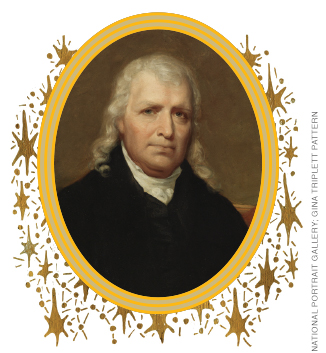
Samuel Chase, another signer of the Declaration of Independence, had been appointed to the Supreme Court in 1796, when the justices still alternated between settling disputes of national import and sitting with lesser judges to hear cases in the circuit courts. Chase proved to be an overbearing and opinionated jurist. His “impetuous nature,” wrote Chief Justice William H. Rehnquist in his book Grand Inquests: The Historic Impeachments of Justice Samuel Chase and President Andrew Johnson (1992), “made him something of a stormy petrel.” His ruddy complexion earned him the nickname Old Bacon Face.
Irascibility is hardly an impeachable offense—otherwise, scores of federal judges would have been stripped of their robes by now. But Chase’s peremptory ways and predictably pro-Federalist rulings antagonized Democratic-Republican President Thomas Jefferson. Chase had been at his high-handed worst in trying a treason case: he’d ordered the defendant’s lawyers to stick to the facts and refrain from giving their opinion as to whether these met the legal definition of treason—a ruling so resented by Chase’s fellow judges that they quit the trial. Chase backed down, but his colleagues stayed away, and the defendant was convicted and sentenced to death without them. Once, while charging a grand jury in Baltimore, Chase had disparaged Jefferson’s policies and groused about proposed changes to the Maryland constitution.
The latter case had prompted Jefferson to fire off a note to a member of the House leadership:
“Ought this seditious and official attack on the principles of our Constitution, and on the proceedings of a State, to go unpunished? And to whom so pointedly as yourself will the public look for the necessary measures? I ask these questions for your consideration, for myself it is better that I should not interfere.”
The president got his way. Pursuant to Article II, section 4 of the Constitution—“The President, Vice President and all civil Officials of the United States, shall be removed from Office on Impeachment for, and Conviction of, Treason, Bribery, or other High Crimes and Misdemeanors”—the House voted to impeach Chase on eight counts.
In the heat of the moment, Jefferson may have overlooked the implications of his not-quite interference. The Constitution was only 16 years old, and the three branches of government were still sorting themselves out. If Chase had been convicted and removed from office, cocky Democratic-Republicans in Congress might have gone after other justices and lower-court judges, sparing only those who toed the states’-rights line. But whether Jefferson himself would have endorsed such a purge, Rehnquist writes, “is a much more debatable question.”
Indeed, a slyer president might have tried to rein in the judiciary by targeting an imperious judge from his own party. For the impeachment of an outspoken Federalist by a Democratic-Republican legislature all but cried out “raw politics.” Objectionable as Chase’s partisanship on the bench may have been, it probably helped him somewhat in the court of the Senate.
Also at issue in this, the first really important impeachment case, was the caliber of the weapon. Was impeachment meant to be a last recourse for ousting atrocious public servants, a routine method for cleaning house after a national election changes the party in power, or something in between?
Chase’s trial opened on February 4, 1805, as the greatest show in town: a thousand spectators crowded into the Senate chamber. Presiding was Vice President Aaron Burr, under a cloud for having recently killed Alexander Hamilton in their infamous duel. (By all accounts, Burr acquitted himself capably and honorably throughout the trial.)
The charges against Chase can be summed up as follows: intimidating lawyers and witnesses; flaunting his political biases in court; and committing procedural errors, such as that refusal (subsequently recanted) to give lawyers a say in defining treason. In a three-hour-long opening statement, Hopkinson scoffed that impeaching Chase was “employing an elephant to remove an atom too minute for the grasp of an insect.” No one had accused his client of treason or bribery, so Hopkinson homed in on “high crimes and misdemeanors,” which he argued meant no more or less than offenses indictable under federal law. This reading failed then as it surely would today; especially when it comes to financial wrongdoing, human ingenuity always seems a step or two ahead of the legal system’s ability to enumerate crimes.
In a more philosophical vein, Hopkinson drew upon his knowledge of the Classics to emphasize the threat posed by Chase’s impeachment: “If we have read of the death of a Seneca under the ferocity of a Nero, we have read too of the murder of a Socrates under the delusion of a Republic. An independent and firm judiciary, protected and protecting by the laws, would have snatched the one from the fury of a despot, and preserved the other from the madness of a people.”
In a letter to a friend, Burr summed up Hopkinson’s opening-day performance: “He acquitted himself greatly to his honor. He had method, precision, perspicuity and displayed much ingenuity and knowledge of his subject—yet it was evident that he could have done still better if he had been more at his ease. The novelty of the subject, the scene and the tribunal obviously laid him under some restraint.”
The occasion, in other words, had gotten to Hopkinson—one of the few times on record when he displayed a little human frailty.
It hurt the Democratic-Republican cause that its management was left to Representative John Randolph of Virginia, a volatile advocate of states’ rights. Rehnquist describes Randolph as “the consummate Southern planter, [who] patrolled the House of Representatives in boots and spurs with a whip in hand.” Good at hurling invective but unable to mount a coherent legal argument, Randolph was no match for Hopkinson and his cocounsel.
The March 1 final vote made for high drama, all the more so when an ailing senator had to be carried in on a couch. Although a majority voted to convict Chase on two of the eight counts, it wasn’t enough of a majority: the anti-Chase contingent’s best shot fell four votes short of the requisite two-thirds.
Rehnquist approved of the outcome for its “profound effect” of safeguarding judicial independence. Taking a different view was Raoul Berger, a law professor whose book Impeachment: The Constitutional Problems came out in 1972, just in time for the Watergate crisis. On the grounds that “by his conduct Chase destroyed confidence in the impartial administration of justice,” Berger believed that the Senate could justifiably have cashiered him. One wonders how the case would have turned out if the erratic Randolph and the suave Hopkinson had traded places.
In 1828, Hopkinson was appointed a federal district judge. Most of the cases assigned to him had to do with admiralty (maritime law), at the time a far more important area of the law than it is now. But in one non-admiralty case, he was asked to decide the fate of a black man claimed by a white man as his escaped slave; the black man replied, in essence, “You’ve got the wrong fellow.” Judge Hopkinson sifted through conflicting testimony, kept his cool amid the fraught racial politics, and found for the black man.
Hopkinson’s name came up whenever a Supreme Court vacancy arose, but, as a member of the fading Federalist Party, he was never nominated. When not on the bench or at home with his beloved family, he promoted the arts in Philadelphia (notably as a founder of the Pennsylvania Academy of the Fine Arts), lectured on the law, and served as a Penn trustee. On January 15, 1842, a week after last holding court, Joseph Hopkinson died. He was 71.
The doctrines of impeachment haven’t changed much since 1805. As noted, Hopkinson failed to restrict impeachable offenses to those specified in the criminal code. At the other end of the spectrum stands a lawless claim made in 1970 by then-Representative Gerald Ford during an abortive attempt to get rid of Supreme Court Justice William O. Douglas: “An impeachable offense is whatever the majority of the House of Representatives considers it to be at a given moment in history.” The Clinton case shed little light on the issue; the two counts in his bill of impeachment—perjury and obstruction of justice—seem to fall squarely within the meaning of “high crimes and misdemeanors.” (For the record, neither count garnered even a bare majority for conviction in the Senate.)
At any rate, Joseph Hopkinson’s seminal contribution to the American polity seems built to last. It may not be possible to say what impeachment is for all time and all cases, but Hopkinson helped us to see what it had better not be: a device for picking off the other party’s judges.
Dennis Drabelle G’66 L’69 is the author, most recently, of The Great American Railroad War.


